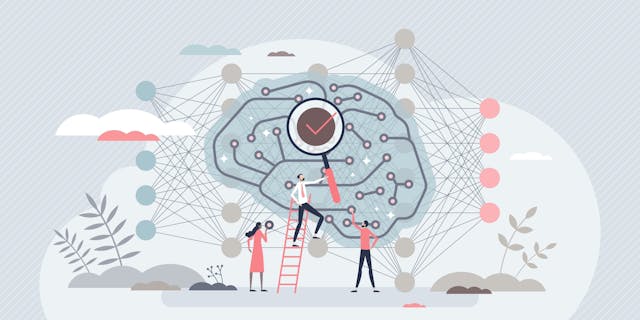AI Explorations and Their Practical Use in School Environments is an ISTE initiative funded by General Motors. The program provides professional learning opportunities for educators, with the goal of preparing all students for careers with AI.
Recently, we spoke with three more participants of the AI Explorations program to learn about its ongoing impact in K-12 classrooms. Here, they share how the program is helping their districts implement AI curriculum with an eye toward equity in the classroom.
Monica Rodriguez is a kindergarten teacher with Ector County Independent School District in Odessa, Texas. She was an ISTE-GM AI Explorations year 4 participant and has implemented projects and presented to her district.
ISTE: How have you taught AI in the classroom?
Rodriguez: I put AI activities on Seesaw for my kindergarteners—for example, the “Senses vs. Sensors” project from the Hands-On AI Projects for the Classroom: A Guide for Elementary Teachers. One learning objective is how humans and animals use their senses to interact with their environment. Another objective is to describe how AI robot sensors mimic those.
There was an activity where my students watched a video clip of an animal and a video clip of a robot. Then, my students recorded themselves discussing how those two were similar and how they were different. And I asked, “If you were an AI robot, what functions and senses would you use mimicking animals or humans?” One of them decided to do an insect robot, explaining how the spider's feet can climb up walls. I led an inventive discussion, asking, “What if technology moved in that direction, where the robot could climb up walls?”
Then, I found a robot that you could build with the wall-climbing function, using suction cups. I gave one to my fifth graders. One of them built it, and then he brought it back to me. He then came and talked to my kindergarteners about how he built it and why he built it that way. My younger kids were so excited. The robot blew their minds! And they thought my fifth grader was a wizard.
What motivates you to teach AI?
We all know that technology is driving our future. Will I be here in the next 20 to 30 years? Who knows? But my babies will be here, and they need to have technical knowledge and also an understanding of what it's capable of doing and how it can be effective.
They need a good foundation. AI is not just a technology for TikTok or taking selfies. It can be used for a lot more. It can be a tool for learning.
For example, I had a Chinese student with very limited knowledge of the English language. Since I was ESL certified, she joined my classroom. I wanted to help her communicate with others, so I put a translator on all of my students’ iPads. Whenever we noticed a gap in communication, we could turn to the translator. So, not only could we express ourselves to her, but she was able to express herself to us in that way. We bridged that gap in communication and learning with AI.
Many of my students started picking up certain words that she was saying. So, she didn't feel like it was just her language; it’s our language. There was a cross-cultural connection. It was amazing! I built up a conversation about it, explaining that, with AI, we can communicate with our friends correctly. We learned to embrace who we are, and how we can share ourselves with AI. It’s so beautiful.
What benefits are there for parents, colleagues and districts when implementing AI lessons and projects?
Our district did a technology night. I spent the time helping some of my fifth graders with coding activities. We had a lot of parents attend, not only face-to-face but virtually as well. We got really strong feedback from the parents. They loved it and wanted to see more.
With our community incorporating those technology nights and parents seeing what students are exposed to and what new technology is out there, it gave them a better understanding of what our students are facing now. I hope that we, as a district, adopt those ISTE standards and set some time to focus on what those standards mean and how they will impact students. Their future is technology-driven.
Renee Sanchez is an instructional leadership support specialist with Los Angeles Unified School District’s Instructional Technology Initiative. She was an ISTE-GM AI Explorations year 4 participant, has implemented projects and presented to her district and has built capacity by inviting and mentoring other LAUSD educators into the AI Explorations program.
ISTE: Why did you join the ISTE-GM AI Explorations professional development (PD) program?
Sanchez: I wanted to know more about computer science when I started as an instructional technology coach. Then, I got even more interested because AI is in our everyday lives. I wanted to understand the concept of AI and how algorithms work.
The AI Explorations PD program is self-paced. And it teaches how AI is related to classrooms, not only in high school, but also in elementary. So, I enrolled in the program.
How have you put what you learned about AI into practice in your district?
There are a lot of good resources shared in the ISTE-GM AI Explorations Program, like the hands-on guides. We use the project called “Laws for AI” from the Hands-On AI Projects for the Classroom: A Guide for Secondary Teachers. The guides were very beneficial in my learning and helped me see what AI education looks like in the classroom. Our team used this resource when we created our AI professional development for district-wide audiences.
L.A. Unified is committed to providing Computer Science (CS) education for all students by 2025, ensuring that all:
- grade 9-12 students have access to a CS pathway.
- grade 6-8 students complete at least one rigorous and relevant CS course.
- grade PK-5 students receive 20 hours of CS instruction each year.
To help our district accomplish that mission, we created the AI PD series for our educators. This year, we're going to expand it. It used to be three professional learning modules. Now, we're adding a fourth. In the beginning, we focused on understanding artificial intelligence and how it could be implemented in the classroom. This fourth session focuses on the implications of emerging technologies, like the internet of things, virtual reality and NFTs.
There are a lot of educators who want to take these professional learning courses. We have 80 educators registered. The last time I checked the list, 127 educators were waiting to be accepted.
Tasha Burke-Peart is a technology program specialist with the School District of Palm Beach County in West Palm Beach, Florida. She was an ISTE-GM AI Explorations year 5 participant and plans to conduct PD on AI for teachers and staff.
ISTE: How will you share what you’ve learned during the AI Explorations PD program with the educators in your district?
Burke-Peart: We just held our 23rd annual technology conference. It’s like a mini ISTE conference with best practices and instructional strategies that teachers can use immediately to integrate technology into their teaching practice. One of the questions that we always ask participants is, “What type of PD or technology or tools would you like to learn more about?”
This year, several teachers asked about AI. They’ve heard of the term, but they don't quite understand how it fits in with what they teach every day. This is an excellent opportunity for us as we plan next year's technology conference. We will include sessions on AI for teachers and share resources that they can use in the classroom.
What is your district’s plan to ensure equity and diversity in AI education?
We have a very diverse population of students in our district. We serve more than 189,000 students who speak 150 languages and dialects. Our goal is to support and nurture all students equally. For us, equity means that each student—regardless of race, ethnicity, poverty, disability, language status, undocumented status, religious affiliation, gender identity or sexual orientation—will have access to the opportunities, resources and support they need to imagine, nurture and achieve success.
That being said, all of our students need to understand how the principles of AI and computational thinking relate to their lives. Future PD in AI will be designed to show teachers how to integrate these principles into lessons for all students.
How is your district “putting students in the driver’s seat” when learning AI?
As an educator, I don't have to know everything about AI before bringing it to teachers and students. Students have a huge capacity to troubleshoot and solve problems, as long as we affirm that ability within them. Students need to be okay with troubleshooting in learning AI, thinking about why something failed and what changes they can make before trying again.
The more we put students in the driver's seat, the more we can empower them to create in the future. Here are some great tools I discovered from the ISTE-GM course that can empower both teachers and students:



